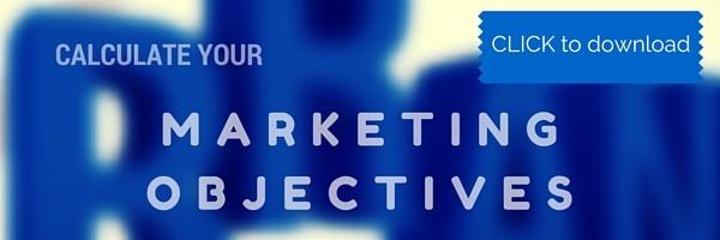Is the juice going to be worth the squeeze?
As you put on your optimist's hat, looking into the future, determining how you intend to grow your business, let me offer one piece of wisdom: when it comes to marketing, calculable ROI is not out of the question... even with non-digital marketing.
If you have benchmarks, you can even come up with a formulaic plan that will tell you X amount of dollars invested in marketing should generate X amount of ROI.
Here's how:
First, it's important to understand how vital benchmarks are to establishing realistic projections. They're not nice to have... they're critical when it comes to forecasting, which is, of course, critical to determining whether the potential roi is worth the risk... or, if the juice is worth the squeeze.
If you don't have any benchmarks established, this exercise will help you set them, and if you already have them, this will help you leverage them in your marketing planning.
If you don't have it already, download our marketing objectives calculator tool to crunch your numbers as we go through the exercise:
Step 1: Establish your objectives
Put some concrete objectives for your marketing investment. Specifically outline what, exactly, you want it to accomplish for you over the course of 12 months or more.
Not sure? Step back and look at your overall business objectives when it relates to sales. Are you trying to grow your business? ... reverse declining sales trends? ... launch new products or services?
If this is about growing your business or reversing declining sales trends for you, keep reading. This article is not specific to product or services development.
HOW TO DO IT ESTABLISH MARKETING GOALS:
So, let's talk about those objectives... what is the financial piece if it look like? $1,000,000 in YOY growth? $10,000,000 YOY growth?
Second, if you changed NOTHING in your business for the upcoming year compared to what you did this last year, how close to those goals do you project you'll be? Okay, so that's the number we're going to focus on - the gap.
I'm sure you're going to have some attrition, so it's not uncommon for business owners and marketing leaders to approach me with a gap that is actually larger than their overall objectives. It's also not uncommon for businesses to have several investments in play that will work with marketing, so the gap can be smaller.
MORE LIKE THIS: 4 Examples of Marketing Objectives that Lead to Awesome ROI
Step 2: Determine methodologies & tactics to be used
There are any number of marketing methodologies you can deploy to reach your goals. You could run PPC ads on Google or social media. You could run radio or print ads... even rent space on a billboard.
If your growth goals are $600,000/year or more, a marketing agency specializing in the inbound methodology could be the biggest bang for your buck your overall best bet for marketing success. Read more about pricing here to see why that's the case.
What is inbound marketing? It's about attracting visitors to your website with SEO, social media, blogging, and optimized website/landing pages, converting quality visitors into leads with content offers, and then nurturing them until ready for the sales hand-off. It's all housed online, and leverages tools for execution AND analysis.
I usually suggest a combination of inbound and something else... or inbound and a couple of something else.
The reason is that inbound is ingrained with the formula that makes measurable ROI possible... if you execute it fully and use software that captures all of the data you need.
The most common arrangement for us is inbound with PPC advertising on Adwords and/or social media. Inbound gives you long, organic play. It drives traffic to your website through Google, Yahoo, and Bing, which is important for those thinking beyond year 1, because it will REALLY start to hit its stride at about month 12. But most of you don't have the patience to wait 12 months for tangible results. This is why I suggest adding PPC to accelerate your learning curve, so you can start achieving meaningful results by months 3 or 4.
Step 3: Develop the digital foundation
Before pumping any money into PPC, I suggest you set up the inbound foundation first. It requires tools for delivery AND analysis. The latter will help with measuring all of our other marketing efforts as well, because we're going to incorporate them together!
Set up your tools first.
We use Hubspot for inbound marketing, which makes it easy for us to measure what people do on email and your website.
We can create unlimited landing pages, which can be customized for your individual campaigns. We can send emails through it, post on social media, develop our keyword strategy, and create and track campaigns.
If we're setting up AdWords ads, there are options to leave a tracked phone number. You can also set up a new phone number through Google, and have it be the sold number used for specific campaign types.
Step 4: Integrate non-digital components
This is where it can get interesting... If you're sending out mailers, put your trackable phone number on the card along with a link to a landing page vs regular site page. Any actions that occur on this page should be trackable. If using Hubspot, every CTA or form you create is automatically tracked for views, clicks, and submissions. Even if somebody doesn't convert on the form, you'll be able to determine benchmarks.
For example, if you send 1,000 mailers and get 200 visitors to the website, which results in 40 leads, and you're able to close 2 of those into customers, you'll have the entire customer acquisition costs nailed... which will help you determine if the outcomes are worth the investment.
If you JUST send those mailers out and include a phone number and website home page URL, you'll have NO way of knowing how much of that resulted in visits, leads, or customers. This makes it difficult to fine-tune your campaign.
Think about it - if you know people are coming to the website, but they're STILL not converting, you'll know that the changes need to be made on the landing page.
Step 5: Measure, analyze, ideate
Since you're using digital tools like Hubspot, you'll be able to easily see whether something your marketing people published is working. When it's not, you'll be able to hone in on how to course correct. The reality is that you're not going to nail it 100% out of the gate. So, having these benchmarks will help you make small adjustments and tweaks to your different programs to improve performance over time.
Here is some data worth measuring:
- Landing page visits-to-form-submissions (20% or higher is good for b2b)
- Website visitors-to-contacts (2 - 5% is desirable)
- Email open rates
- Email click rates
- Website visitors per month
- Time on the website (and high-impact pages)
- Bounce rates
Things related to time on the website and bounce rates are going to be measured globally AND based on the individual content for a good cause.
For example, a long-form blog post is likely to require more reading than a site or landing page, which means that your best posts could have an average time on the page of 5 - 10 minutes or more. But it could still have a very high bounce rate, which means people are leaving without taking action. Whereas, a landing page could have a 30-second average time on the page, but if people are converting at a 20% rate or higher, that's probably actually a good thing.
The point is - take the time to analyze the data. Then, come up with ways to improve, and make sure that you have a solid gameplan for measuring success.
Step 6: Calculate your ROI
Once you have that formula in place to determine how much your marketing investments are paying off, you can start comparing your spend on different tactics to actual results.
To achieve accuracy, make sure you don't have multiple campaigns funneling into a single measuring device. You don't want mailers, PPC ads, and organic traffic all being pushed through the same landing pages, forms, CTAs, etc.
Step 7: Create reasonable projections
For this, I suggest that you talk to an inbound marketing agency representative, regardless of whether this is your first major investment into marketing or your 20th. We're going to analyze the data differently, and we're even equipped to make projections with less than the ideal amount of information.
If your marketing goals are less than $600,000/year growth, the agency route isn't going to be much help, but you can always find a contractor with experience working with companies your size to provide you a reasonable idea of what to expect.
CONCLUSION:
Try to remember that these are just projections, and marketing is only ONE part of the puzzle when it comes to completing a sale. That said, we can provide some color to your goals and expectations if you're looking for help in this regard.
Check out our Growth Plan Builder to generate a plan to help your business take off:




